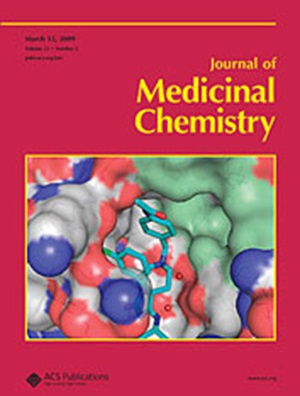Discovery and Characterization of PVTX-321 as a Potent and Orally Bioavailable Estrogen Receptor Degrader for ER+/HER2– Breast Cancer
IF 6.8
1区 医学
Q1 CHEMISTRY, MEDICINAL
引用次数: 0
Abstract
Estrogen receptor α (ERα) is a key therapeutic target in ER+/HER2– breast cancer, but ESR1 mutations drive resistance to endocrine therapies. Heterobifunctional degraders (HBDs) targeting ERα offer a promising strategy to overcome this resistance. Here, we report PVTX-321 (16a), a potent ER HBD derived from a novel spirocyclic cereblon ligand and an ERα binder. PVTX-321 achieves a DC50 of 0.15 nM in MCF-7 cells and acts as a strong antagonist (IC50 = 59 nM), suppressing proliferation in ERα+ cell lines, including mutant variants (Y537S, D538G). It demonstrates favorable oral bioavailability, dose-dependent ERα degradation in vivo and induces tumor regression at 10 mg/kg (QD) in MCF-7 xenografts. With minimal CYP inhibition and a strong preclinical safety profile, PVTX-321 is a promising candidate for advancing ER+/HER2– breast cancer treatment.

PVTX-321作为ER+/HER2 -乳腺癌有效的口服雌激素受体降解剂的发现和特性
雌激素受体α (ERα)是ER+/HER2 -乳腺癌的关键治疗靶点,但ESR1突变导致对内分泌治疗的耐药性。靶向ERα的异双功能降解物(HBDs)为克服这种耐药性提供了一种有希望的策略。在这里,我们报道了PVTX-321 (16a),一种由一种新型螺旋环小脑配体和一种ERα结合剂衍生的强效ER HBD。PVTX-321在MCF-7细胞中达到0.15 nM的DC50,并作为强拮抗剂(IC50 = 59 nM),抑制ERα+细胞系的增殖,包括突变变体(Y537S, D538G)。它具有良好的口服生物利用度,在体内具有剂量依赖性的ERα降解,并在MCF-7异种移植物中以10 mg/kg (QD)诱导肿瘤消退。PVTX-321具有很小的CYP抑制作用和很强的临床前安全性,是推进ER+/HER2 -乳腺癌治疗的有希望的候选药物。
本文章由计算机程序翻译,如有差异,请以英文原文为准。
求助全文
约1分钟内获得全文
求助全文
来源期刊

Journal of Medicinal Chemistry
医学-医药化学
CiteScore
4.00
自引率
11.00%
发文量
804
审稿时长
1.9 months
期刊介绍:
The Journal of Medicinal Chemistry is a prestigious biweekly peer-reviewed publication that focuses on the multifaceted field of medicinal chemistry. Since its inception in 1959 as the Journal of Medicinal and Pharmaceutical Chemistry, it has evolved to become a cornerstone in the dissemination of research findings related to the design, synthesis, and development of therapeutic agents.
The Journal of Medicinal Chemistry is recognized for its significant impact in the scientific community, as evidenced by its 2022 impact factor of 7.3. This metric reflects the journal's influence and the importance of its content in shaping the future of drug discovery and development. The journal serves as a vital resource for chemists, pharmacologists, and other researchers interested in the molecular mechanisms of drug action and the optimization of therapeutic compounds.
 求助内容:
求助内容: 应助结果提醒方式:
应助结果提醒方式:


